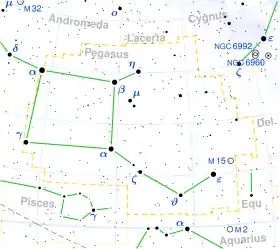Nu Pegasi
ν Pegasi, Latinized as Nu Pegasi is a single[12] star in the northern constellation of Pegasus. It is an orange-hued star that is faintly visible to the naked eye with an apparent visual magnitude of 4.84.[2] The star is located approximately 261 light years away based on parallax,[7] but is drifting closer with a radial velocity of −19 km/s.[6]
| Observation data Epoch J2000 Equinox J2000 | |
|---|---|
| Constellation | Pegasus |
| Right ascension | 22h 05m 40.75170s[1] |
| Declination | 5° 03′ 30.7201″[1] |
| Apparent magnitude (V) | 4.84[2] |
| Characteristics | |
| Evolutionary stage | red giant branch[3] |
| Spectral type | K4III[4] |
| U−B color index | +1.80[2] |
| B−V color index | +1.44[2] |
| Variable type | suspected[5] |
| Astrometry | |
| Radial velocity (Rv) | −18.90[6] km/s |
| Proper motion (μ) | RA: +101.759[7] mas/yr Dec.: +100.923[7] mas/yr |
| Parallax (π) | 12.4810 ± 0.3322[7] mas |
| Distance | 261 ± 7 ly (80 ± 2 pc) |
| Absolute magnitude (MV) | 0.26[8] |
| Details[9] | |
| Mass | 1.13 M☉ |
| Radius | 24.57 R☉ |
| Luminosity | 149 L☉ |
| Surface gravity (log g) | 1.72 cgs |
| Temperature | 4,073 K |
| Metallicity [Fe/H] | +0.02 dex |
| Rotational velocity (v sin i) | 2.3[10] km/s |
| Age | 8.1+2.3 −0.4[3] Gyr |
| Other designations | |
| Database references | |
| SIMBAD | data |
This is an aging giant star, most likely (94% chance) on the red giant branch,[3] with a stellar classification of K4III.[4] It is a suspected variable, with a magnitude range observed from 4.83 to 4.86.[5] With the supply of hydrogen at its core exhausted, the star has cooled and expanded to 24.6 times the Sun's radius. It is 13% more massive than the Sun and is radiating 149 times the Sun's luminosity from its swollen photosphere at an effective temperature of 4,073 K.[9]
References
- Van Leeuwen, F. (2007). "Validation of the new Hipparcos reduction". Astronomy and Astrophysics. 474 (2): 653. arXiv:0708.1752. Bibcode:2007A&A...474..653V. doi:10.1051/0004-6361:20078357. Vizier catalog entry
- Ducati, J. R. (2002). "VizieR Online Data Catalog: Catalogue of Stellar Photometry in Johnson's 11-color system". CDS/ADC Collection of Electronic Catalogues. 2237. Bibcode:2002yCat.2237....0D.
- Stock, Stephan; et al. (August 2018). "Precise radial velocities of giant stars. X. Bayesian stellar parameters and evolutionary stages for 372 giant stars from the Lick planet search". Astronomy & Astrophysics. 616: 15. arXiv:1805.04094. Bibcode:2018A&A...616A..33S. doi:10.1051/0004-6361/201833111. A33.
- Houk, N.; Swift, C. (1999). "Michigan catalogue of two-dimensional spectral types for the HD Stars". Michigan Spectral Survey. 5. Bibcode:1999MSS...C05....0H.
- Samus, N. N.; Durlevich, O. V.; et al. (2009). "General Catalogue of Variable Stars (Samus+ 2007-2013)". VizieR On-line Data Catalog: B/gcvs. Originally Published in: 2009yCat....102025S. 1. Bibcode:2009yCat....1.2025S.
- Famaey, B.; et al. (2005). "Local kinematics of K and M giants from CORAVEL/Hipparcos/Tycho-2 data". Astronomy & Astrophysics. 430: 165. arXiv:astro-ph/0409579. Bibcode:2005A&A...430..165F. doi:10.1051/0004-6361:20041272.
- Brown, A. G. A.; et al. (Gaia collaboration) (August 2018). "Gaia Data Release 2: Summary of the contents and survey properties". Astronomy & Astrophysics. 616. A1. arXiv:1804.09365. Bibcode:2018A&A...616A...1G. doi:10.1051/0004-6361/201833051. Gaia DR2 record for this source at VizieR.
- Anderson, E.; Francis, Ch. (2012). "XHIP: An extended hipparcos compilation". Astronomy Letters. 38 (5): 331. arXiv:1108.4971. Bibcode:2012AstL...38..331A. doi:10.1134/S1063773712050015. Vizier catalog entry
- Reffert, Sabine; et al. (2015). "Precise radial velocities of giant stars". Astronomy & Astrophysics. 574: A116. arXiv:1412.4634. Bibcode:2015A&A...574A.116R. doi:10.1051/0004-6361/201322360. hdl:10722/215277. Vizier catalog entry
- De Medeiros, J. R.; Mayor, M. (1999). "A catalog of rotational and radial velocities for evolved stars". Astronomy and Astrophysics Supplement Series. 139 (3): 433. arXiv:astro-ph/0608248. Bibcode:1999A&AS..139..433D. doi:10.1051/aas:1999401. Vizier catalog entry
- "nu. Peg". SIMBAD. Centre de données astronomiques de Strasbourg. Retrieved 2019-10-01.
- Eggleton, P. P.; Tokovinin, A. A. (September 2008). "A catalogue of multiplicity among bright stellar systems". Monthly Notices of the Royal Astronomical Society. 389 (2): 869–879. arXiv:0806.2878. Bibcode:2008MNRAS.389..869E. doi:10.1111/j.1365-2966.2008.13596.x.
